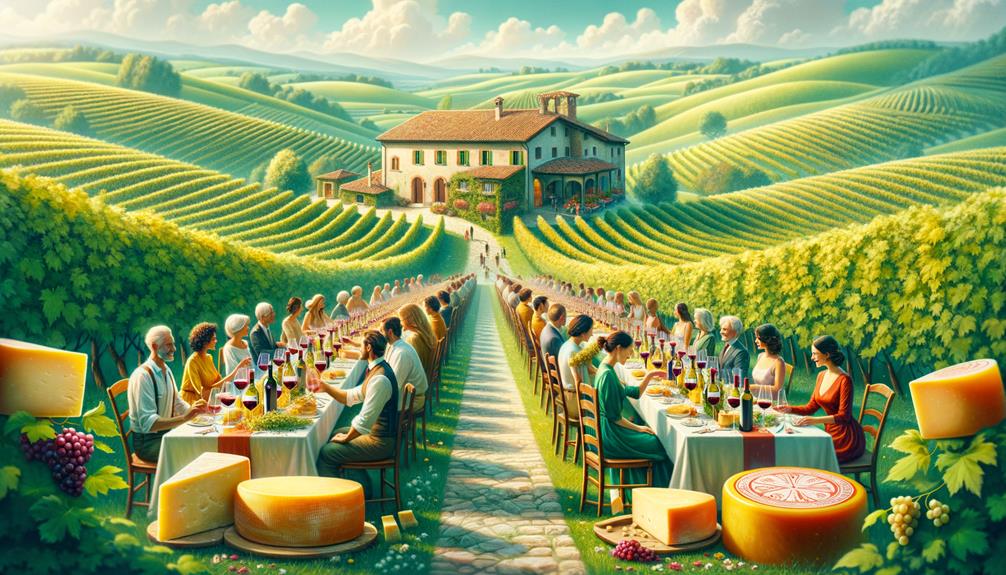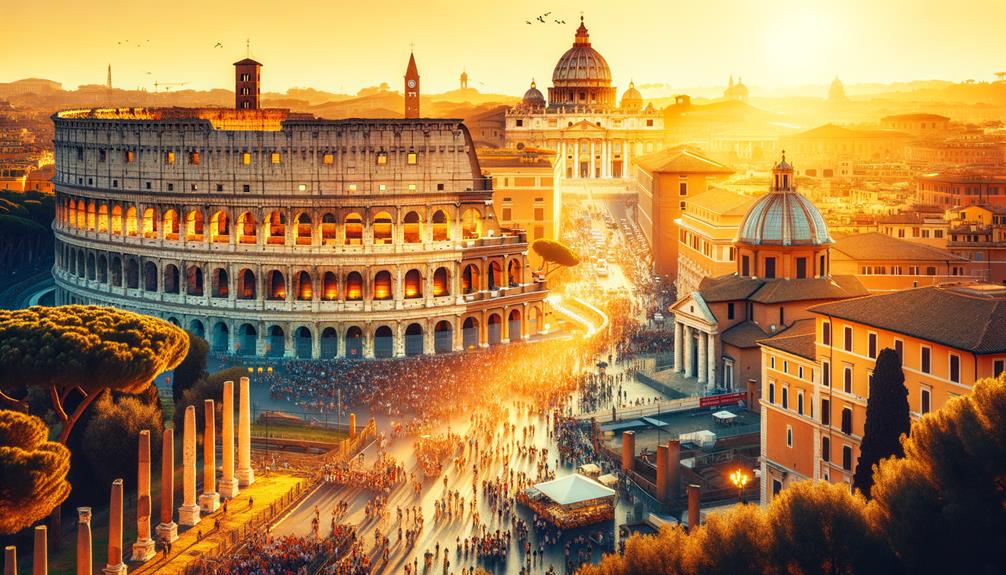Parma has always fascinated me with its blend of tradition and flavor. Walking through a Parmigiano Reggiano dairy, the smell of aging cheese is both inviting and intriguing. Watching the artisans at work, their dedication to perfection is evident as they inspect each wheel meticulously before it earns its branding. The tours offer more than just a taste; they provide insight into the detailed process behind each bite. The suggested pairings really enhance the experience. So, how do you pick the right tour?
The Charm of Parma
Who could resist the pull of Parma, a city where history, culture, and the rich aroma of Parmigiano Reggiano come together so perfectly? As I walked along the cobblestone streets, Parma's charm wrapped around me. The air was filled with the scent of aged cheese, tempting everyone nearby. This city, in the heart of Italy, offers a delightful mix of timeless beauty and culinary treats.
In Parma, Parmigiano Reggiano is more than just cheese; it's a tradition. Made from simple ingredients like milk, salt, and rennet, it undergoes a careful process. You can visit dairies to see the cheese being cooked, molded, and salted. Watching the wheels of Parmigiano Reggiano mature in large, temperature-controlled rooms is fascinating. Each wheel is tended to every day, waiting to reach its peak flavor over at least 24 months.
Parma's commitment to quality shines through with every bite of Parmigiano Reggiano. As I roamed the city, I felt a strong connection to a culinary tradition that's thrived for nearly a thousand years. This isn't just a place to see; it's a place to experience and savor.
History of Parmigiano Reggiano
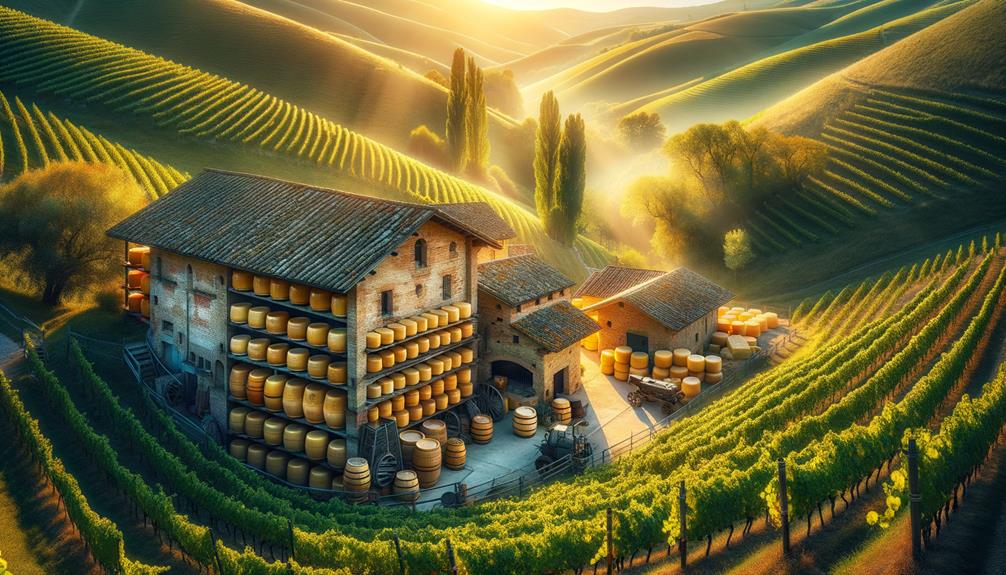
Strolling through Parma, I found myself pondering how this historic city became known for Parmigiano Reggiano, a cheese that has delighted people for nearly a thousand years. The story of Parmigiano Reggiano is as rich and complex as the cheese itself. It began in the medieval monasteries of Parma and Reggio Emilia, where monks first perfected its production. Using just milk, salt, and rennet, they created a cheese that would endure through the ages.
As I wandered the cobblestone streets and admired the ancient buildings, I thought about the dedication and skill needed to craft this renowned cheese. Each wheel is aged for at least 12 months, with some maturing for 24 months or more, before undergoing strict quality checks. Only the finest wheels earn the hot-iron branding from the Consortium del Formaggio Parmigiano Reggiano.
The aging rooms, where the cheese wheels rest and are carefully tended to, showcase the artistry involved in making Parmigiano Reggiano. This unique process, deeply connected to the land and its people, has maintained a tradition that continues to inspire and satisfy.
The Cheese-Making Process
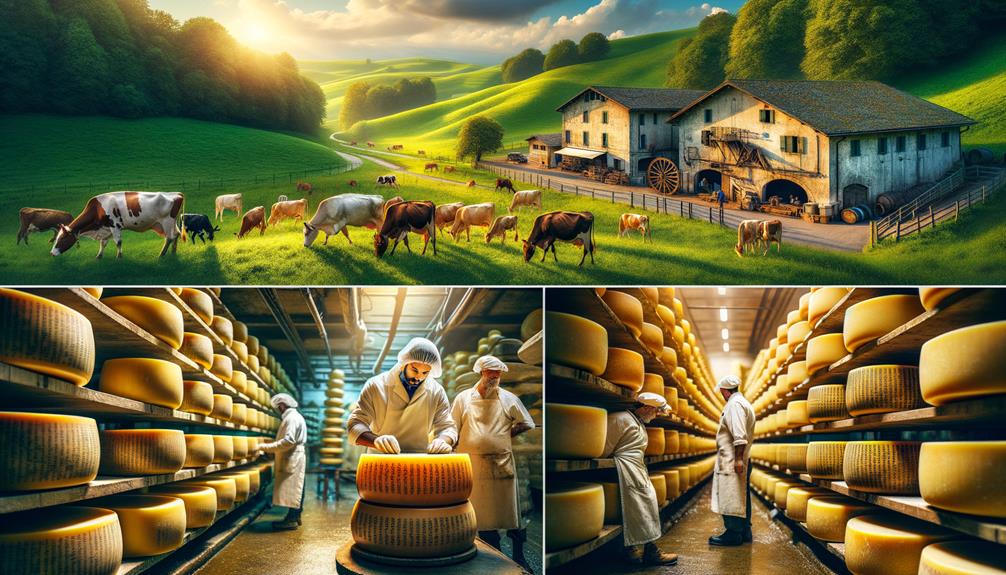
Watching the cheese-making process up close was fascinating. The attention to detail in each step, from following age-old recipes to the careful aging and maturing, really showcases the skill of the artisans. Strict quality control ensures that every wheel of Parmigiano Reggiano lives up to the high standards established by generations of cheese makers.
Traditional Cheese Recipes
In the heart of Parma, the meticulous process of making Parmigiano Reggiano starts with selecting and heating fresh milk. Watching the cheese makers work is truly impressive. The milk is warmed in large copper vats, and rennet is added to thicken it. Once it curdles, the mixture is cut into tiny pieces, cooked, and then shaped into the famous cheese wheels.
The wheels are then soaked in a salt brine, which gives them their unique flavor. This step is crucial for developing the distinct taste of Parmigiano Reggiano. The care and attention given to each wheel are evident; the process is as much about passion as it is about precision.
- Watch how the copper vats are used to heat the milk.
- Observe the curd being cut and cooked.
- Learn why the salt brine is so important.
- See the cheese wheels being formed and shaped.
The dedication and craftsmanship in Parma's cheese making are truly inspiring. It's a farm-to-table journey rich in tradition and love.
Aging and Maturing Process
The moment the cheese wheels enter the maturation room, they start a careful aging process that turns them into the delicious Parmigiano Reggiano we all love. As I watch, the massive wheels sit on wooden shelves, each one destined to become a flavor masterpiece. The room is cool and dark, filled with the earthy scent of aging cheese.
Every day, experts tend to these wheels, rotating them with precision to ensure even aging. This careful rotation prevents mold from forming and helps the cheese develop its unique granular texture. It's fascinating how each wheel is treated like a living entity, nurtured and cared for over months, sometimes years.
The aging process requires patience. At least 24 months are needed for the cheese to reach its best flavor, though some wheels are left to mature for 36 months or more, adding to their complexity. Every turn, every movement, is part of a process that brings out the rich, nutty taste of Parmigiano Reggiano.
It's clear that the journey from milk to aged cheese is an art form. Each wheel tells a story of time, care, and tradition, ending in the beloved Parmigiano Reggiano.
Quality Control Standards
Walking through the bustling cheese-making facility, I can't help but admire the careful attention to detail that ensures each wheel of Parmigiano Reggiano meets top-quality standards. The journey begins with fresh milk being cooked, moulded, and salted, demanding precision at every stage.
In the maturation rooms, rows of cheese wheels rest under the vigilant eyes of dedicated experts. These wheels go through rigorous tests to confirm they meet the strict standards set by the Consortium del Formaggio Parmigiano Reggiano. The maturation process, lasting at least 24 months, is crucial. Every day, these wheels are carefully turned and checked for the right degree of ripeness.
Before they're branded with a hot iron, each wheel undergoes a thorough quality check. Only those that pass these stringent tests earn the Parmigiano Reggiano designation. This quality control process isn't just about keeping up tradition; it's about preserving what makes Parmigiano Reggiano unique and irreplaceable.
- Watch master cheese makers at work
- Learn about the cooking, moulding, and salting stages
- Experience the rigorous quality checks firsthand
- Understand the importance of the maturation process
Selecting the Right Tour

Picking the ideal Parmigiano Reggiano tour depends on several factors like duration, cost, language options, and unique experiences—such as visiting a traditional dairy or enjoying a wine pairing. Each tour has its own charm. For example, the popular Group 1: Parmigiano Reggiano Tours offers a 5-hour deep dive into the cheese-making process with English support, perfect for those wanting a thorough understanding.
If you prefer a mix of activities, the Italian Days Small Group Tour is a great choice. It includes transportation from Bologna and multiple tastings, making it a fantastic option for those who want an all-in-one experience. Another good option is the Parmigiano Reggiano Consortium, which offers tours from different dairies, priced between 15 and 25 Euros, some with English-speaking guides.
For the adventurous, Group 7: Bike and Food Tours combines cycling with culinary delights, ideal for those who enjoy outdoor activities and gourmet experiences. Each tour has something unique to offer, so it's important to choose one that matches your interests and preferences.
Timing Your Visit
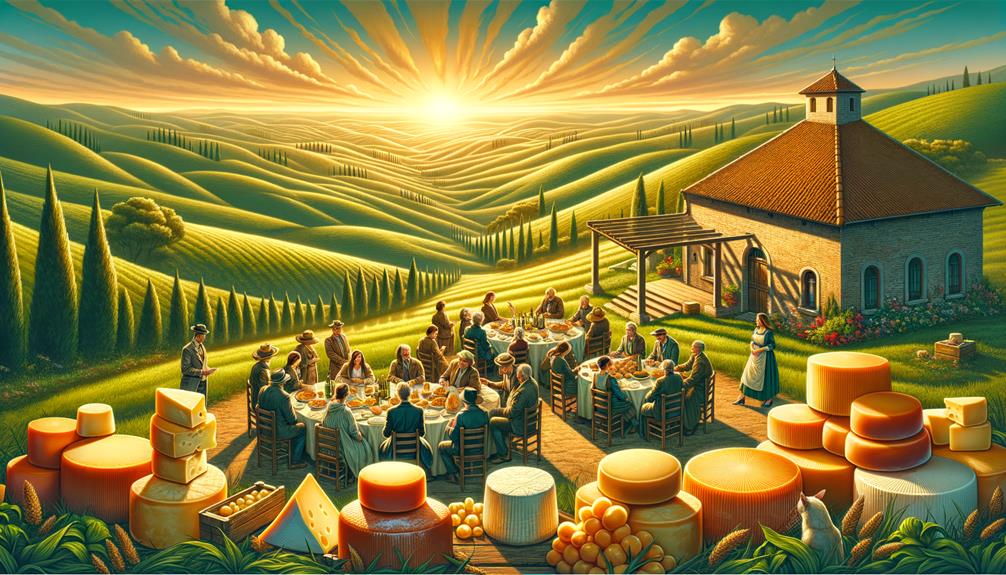
Timing your visit to a Parmigiano Reggiano tour can significantly impact your experience. To see the cheese-making process at its best, aim for the early morning when the factory is bustling with activity. Arriving at dawn lets you catch the milk delivery, curd cutting, and the transformation of raw ingredients into those famous golden wheels of cheese.
Spring and autumn are particularly great times to visit. The weather is pleasant, and the countryside around Parma is vibrant and colorful, adding to the overall experience. Plus, the fresh milk from cows grazing on lush pastures during these seasons enhances the flavor of the cheese.
Here are some tips to make the most of your visit:
- Book 3-4 days in advance: This ensures you get the timing that works best for you.
- Arrive early: This way, you can see the cheese-making process from start to finish.
- Choose spring or autumn: Enjoy the best weather and beautiful scenery.
- Sample different ages: Taste Parmigiano Reggiano at various stages of maturity, along with delicious ricotta and honey.
Timing truly shapes the magic of a Parmigiano Reggiano tour.
Navigating the Dairy Farms

As I drove through the countryside's winding roads, the charm of the dairy farms greeted me warmly. Meeting local farmers gave me insight into their daily routines and dedication to making Parmigiano-Reggiano. Watching the cheese production process, I was impressed by their careful attention to each step, from milking the cows to aging the cheese wheels.
Meeting Local Farmers
As I meander through the dairy farms nestled in the picturesque countryside, I eagerly anticipate meeting the local farmers and uncovering the time-honored methods behind Parmigiano Reggiano production. The verdant, rolling fields and the crisp, fresh air create the ideal backdrop for this enriching experience. Every dairy farm, including the famous cheese factory in Parma, cherishes a strong bond with its cheese makers, who are dedicated to upholding traditional techniques.
Upon arriving at one of the dairies, I notice the farmers hard at work, their hands reflecting years of commitment. They greet visitors warmly, eager to share their passion and expertise. The sight of cows grazing peacefully in the fields, along with the steady hum of milking machines, paints a vivid picture of rural tranquility.
- Check with dairies ahead of time to confirm tour availability.
- Consider taking a taxi due to the remote locations of many dairies.
- Visit Quattro Madonne near Modena for a convenient option close to the city.
- Dive into learning about the history and process of Parmigiano Reggiano straight from the experts.
Meeting these farmers offers a unique glimpse into the essence of Parmigiano Reggiano, making the journey truly memorable.
Exploring Cheese Production
As I step into the world of cheese production, I'm immediately greeted by a blend of sights, sounds, and smells. The dairy farms where Parmigiano Reggiano is made are a maze of tradition and history. Cows roam freely on green pastures, their milk being the foundation of this iconic cheese. The farms are a testament to generations of skilled craftsmanship.
Walking through the barns, it's clear how much care and attention the farmers put into their work. Fresh, unpasteurized milk is collected twice a day to keep its rich flavor. Watching the milk turn into curds, then being cut and molded, it's easy to imagine the delicious cheese tastings that lie ahead.
The aging rooms are a feast for the senses too. Stacks of cheese wheels are meticulously checked and turned, filling the air with the earthy and nutty scent of aging Parmigiano Reggiano. Each phase of the process, from milking to aging, is steeped in tradition and passion.
In these moments, I feel a deep connection to the land and its timeless cycles. Visiting these dairy farms is a tribute to heritage and taste.
Tasting Techniques

Tasting Parmigiano Reggiano is a sensory journey, each detail—from its golden color to its rich aroma—enhances the experience of this exceptional cheese. The texture and flavor tell a story, ranging from fruity and floral to nutty and savory. The cheese's age significantly impacts its taste; younger Parmigiano Reggiano is milder and creamier, while aged varieties bring a robust, granular texture.
To truly enjoy Parmigiano Reggiano, I recommend taking small pieces and letting them melt slowly in your mouth. This way, the complex flavors can unfold naturally, revealing layers that are both intricate and harmonious. The optimal temperature for tasting is between 20°C to 24°C (68°F to 75°F), which best showcases the cheese's natural aromas and flavors.
Here's a simple guide to appreciate it fully:
- Look at the color: A golden hue indicates good quality.
- Feel the texture: Younger cheese is creamier, while older cheese is more granular.
- Smell the aroma: Notice the rich, savory scent that wafts from the cheese.
- Taste it slowly: Let small pieces dissolve to appreciate the full flavor profile.
Pairing Suggestions

Pairing Parma cheese with the right accompaniments can really make its nutty richness shine. Personally, I find a robust red wine does the trick. Adding sweet figs and crunchy walnuts also brings a delightful contrast to the mix. Let's dive into these combinations to enrich our tasting experience!
Wine and Parma Cheese
Pairing wine with Parmigiano Reggiano can turn a simple tasting into an unforgettable experience, especially when a sparkling red Lambrusco brings out the cheese's nutty and fruity flavors. Imagine savoring a piece of aged Parmigiano Reggiano, its granular texture melting into rich, umami goodness. Now, take a sip of Lambrusco: its bubbles cut through the cheese's richness, creating a perfect balance on your palate.
For a luxurious treat, try slices of Prosciutto di Parma alongside Parmigiano Reggiano with a glass of Chianti. The prosciutto's saltiness pairs wonderfully with the cheese's nuttiness, while the Chianti's tannins add a refreshing contrast. If you're in the mood for something sweet, a 24-month-aged Parmigiano Reggiano goes beautifully with Moscato d'Asti, blending savory and sweet notes seamlessly.
Choose Lambrusco: Enhances Parmigiano Reggiano's nutty and fruity flavors.
Try Chianti: Perfect with both Parmigiano Reggiano and Prosciutto di Parma.
Opt for Moscato d'Asti: Great with 24-month-aged Parmigiano Reggiano.
Match age: Younger cheeses with younger wines, older with older wines.
With these pairings, your Parmigiano Reggiano tasting will be extraordinary.
Fruit and Nut Pairings
Imagine sinking your teeth into a crisp apple slice, its sweetness balancing the nutty richness of Parmigiano Reggiano. It's a delightful experience, where the fresh, juicy apple brings out the cheese's complex, savory flavors. But that's just the beginning. Try pairing the cheese with the earthy crunch of almonds or the slightly sweet pistachios, each nut highlighting different aspects of Parmigiano Reggiano's umami notes.
Dried fruits like apricots and prunes offer another tasty contrast. The chewy, sweet texture of an apricot complements the crumbly, salty bite of aged Parmigiano Reggiano. And figs? Their jammy sweetness pairs wonderfully with the cheese's robust flavor. Here's a quick guide to some great pairings:
| Fruit/Nut | Characteristics | Pairing Notes |
|---|---|---|
| Apples | Crisp and sweet | Highlights nutty richness |
| Pears | Juicy and fresh | Complements savory notes |
| Apricots (Dried) | Chewy and sweet | Balances salty, aged flavors |
| Figs | Sweet and jammy | Contrasts with crumbly texture |
| Almonds | Earthy and crunchy | Brings out umami taste |
| Hazelnuts | Rich and toasty | Adds depth to the creaminess |
| Pistachios | Nutty and slightly sweet | Complements rich, savory flavors |
Each pairing enhances the Parmigiano Reggiano experience, making every bite a journey of flavors and textures.
Booking Your Tour

Booking Your Tour
To secure your spot on a Parmigiano Reggiano tour, it's best to book 3-4 days in advance through telephone, email, or a request form. The anticipation builds as you plan your visit, knowing that the tour price varies depending on your group's size. With a minimum of four people required, smaller groups of up to ten can expect to pay €15.00 per person, while larger groups enjoy a reduced rate of €10.00 per person. Children between 6 and 12 years old benefit from a discounted rate of €5.00, and those under 6 years can join for free.
As you finalize your booking, you can almost taste the rich, nutty flavor of Parmigiano-Reggiano. The tour promises an immersive experience, including a visit to the cheese factory, the intricate manufacturing processes, and the aging warehouse. For those who crave a deeper connection with the source, there's an optional visit to a dairy farm.
- Book your tour 3-4 days in advance to confirm availability.
- Check group sizes for the best rates.
- Include children to take advantage of discounted prices.
- Consider the optional dairy farm visit for a fuller experience.
This journey is more than just a tour—it's an exploration of tradition and taste.
Insider Tips
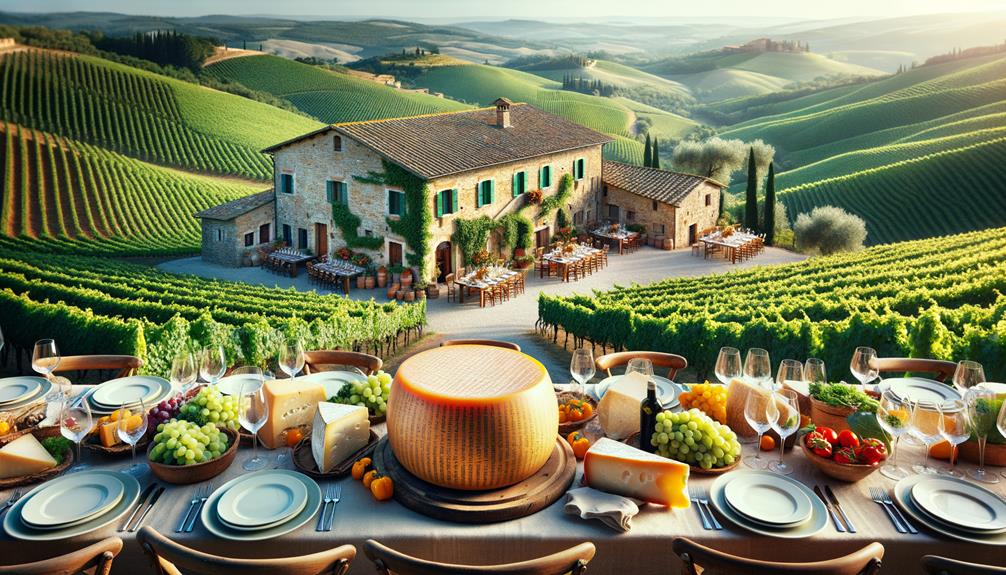
To make the most of your Parma cheese tasting tour, get there early. This gives you time to enjoy the peaceful countryside and chat with the local artisans before the official tour starts. The early morning light beautifully illuminates the rolling hills, making it a great time for some photos and to take in the fresh air.
During the tasting, being in a smaller group can be more rewarding. You'll have the chance to ask the cheesemakers detailed questions and even participate in some of the steps of making parmigiano-reggiano cheese. The smell of freshly cut cheese is something you won't forget.
| Tip | Description |
|---|---|
| Arrive Early | Enjoy the peaceful countryside and meet the artisans. |
| Small Groups | Allows for a more personal and interactive tour. |
| Ask Questions | Learn more about the detailed cheese-making process. |
| Photography | Capture the beautiful landscapes around you. |
| Savor Slowly | Take your time to appreciate each flavor. |
Following these tips will make your Parma cheese tasting tour a memorable experience. Take it slow and immerse yourself in the moment.
Frequently Asked Questions
What Is the Parma Cheese and Vinegar Tour?
The Parma Cheese and Vinegar Tour offers a captivating 5-hour experience. You'll visit a cheese factory to see how Parmigiano Reggiano is made, enjoy tastings paired with wine, and learn about the traditional methods used to produce balsamic vinegar, all guided by an expert.
Where Is the Parmesan Factory in Italy?
Did you know that over 3.6 million wheels of Parmesan cheese are made every year? You can visit the Parmesan factory in Reggio Emilia, Italy, to see the cheese-making process firsthand and enjoy its rich, nutty flavor.
Is Costco Parmesan From Italy?
Costco's Parmesan cheese isn't imported from Italy. It's actually made in the USA by Leprino Foods. While they follow a process similar to traditional Parmigiano-Reggiano, they tweak some ingredients and shorten the aging time, making it more affordable and easier to find.
Does Parmesan Cheese Have to Be From Parma?
Did you know that real Parmesan cheese, known as Parmigiano Reggiano, has to come from Parma and nearby areas in Italy? If it's made elsewhere, it's just a knockoff. This ensures you get that genuine, rich flavor that's hard to beat.

